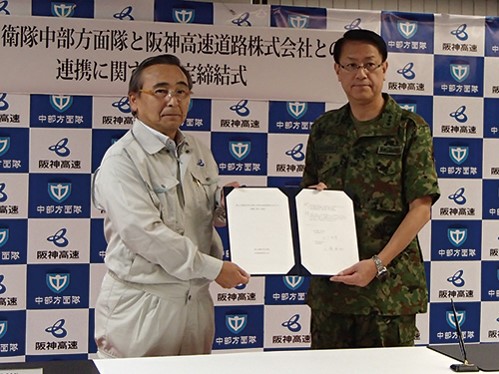

The United Nations Office for Disaster Risk Reduction defines that “Non-structural measures are measures not involving physical construction which use knowledge, practice or agreement to reduce disaster risks and impacts, in particular through policies and laws, public awareness raising, training and education.”
Disaster mitigation measures for roads include "structural measures," such as road slope disaster prevention and mitigation for road slope, for road bridge retrofit, bridge scouring and so on; "non-structural measures," such as building cooperation and coordination systems, raising awareness of disaster prevention, citizen participation for disaster prevention, and stable financial support for disaster; and "social capital," which supports these measures. "Social capital" is discussed later.
In general, it takes a long time to construct structural measures, and they cannot be fully effective against disasters that exceed the target disaster scale. Therefore, it is important to minimize the impact of disasters by implementing feasible non-structural measures before and after the completion of structural measures, and by implementing non-structural measures that can be combined with appropriate structural measures to create complementary and synergistic effects.
Structural measures are mostly the measures that are positioned as "mitigation" in the disaster management cycle. Non-structural measures can be found in a wide range of areas in the disaster management cycle, including mitigation, preparedness, response, and recovery.
Non-structural measures in the "mitigation" category include "building a cooperative and coordinated system," "raising awareness of disaster preparedness," "citizen participation" and "stable financial support". The non-structural measures in the "mitigation" category are more long-term than the non-structural measures in the "preparation" category.
In the event of a large-scale disaster, not only the workload will increase due to the occurrence of the disaster, but also the road management capacity itself will decrease due to the disruption of lifelines, the disconnection of information and communication networks, the damage to road management facilities, and unfortunes to the employees who manage the roads. Therefore, there is a very high possibility that the disaster response of road managers will be limited and they will not be able to carry out a huge amount of emergency response activities promptly.
In such a situation, it would be effective to conclude in advance an "emergency cooperation agreement" between road managers and private contractors, consultant companies, and related companies covering support for various emergency response activities such as the implementation of emergency operations, emergency supply and transportation of goods, etc.
Furthermore, mutual-cooperation agreements between road administrators and local governments have also been observed, and in many cases, agreements are concluded not only for emergencies but also for cooperation during normal times.
This trend was particularly evident in Japan after the Great Hanshin-Awaji Earthquake of 1995, which many lessons on rapid emergency recovery measures.

Figure 2.3.1 Disaster Agreement (Emergency cooperation agreement)
Wait for the report of this 2020-2023 cycle.
1, 2, 3, 5 2013, Y. Tannnaka, Disaster agreements and cooperation with private organizations, Journal of road engineering and management review, vol. 872, November (In Japanese)
4 2016, PIARC TC 1.5 “Risk Management”, Risk management for emergency situations, 2016R26EN
6, 7 (For example) 2012, Chiba prefecture, NEXCO East, and Metropolitan Expressway: "Comprehensive partnership among Chiba prefecture, NEXCO East, and Metropolitan Expressway”, October, https://www.shutoko.co.jp/company/press/h24/data/10/1009/ (In Japanese)
8 (For example) 2011, Hanshin Expressway and 6 other urban expressway companies and public corporation: "Agreement on mutual cooperation in emergency restoration work such as during the earthquake", March, (In Japanese), http://www.hanshin-exp.co.jp/topics2/1330999646F.pdf (In Japanese)
9 (For example) 2009, Hanshin Expressway and Kansai Branch of Japan Federation of Construction Contractors: "Agreement on emergency measure activity in the event of a disaster", April(In Japanese)
10 Ministry of Land, Infrastructure, Transport, and Tourism, Why road "clearing" is done quickly, http://www.thr.mlit.go.jp/road/jisinkannrenjouhou_110311/keikairiyuu.pdf (In Japanese)
11 (For example) 2009, Hanshin Expressway and Kansai Branch of Japan civil engineering consultants association: "Agreement on emergency measure activity in the event of a disaster", April (In Japanese)
12 2011, Kinki Branch of Japan civil engineering consultants association: “Large-scale disaster at Kii peninsula, No.12 Typhoon (In Japanese)
13 Road Division, Panel on Infrastructure Development, MLIT: “For ensuring the reliability of the country, including disaster prevention”, Nov. 2012, http://www.mlit.go.jp/common/000229314.pdf (In Japanese)
14 2019, PIARC TC E.3 ”Disaster management”, Disaster information management for road administrators, 2019R09EN
1 2017, Queensland Government, Queensland Government Crisis Communication Plan, December
1 2017, S. Takeshita et al, Guidelines for Applying the Tendering and Contracting Method in Disaster Recovery, Journal of JACIC information, No. 116, July (In Japanese)
2 2017, Ministry of Land, Infrastructure, Transport, and tourism of Japan, Guidelines for Applying the Tendering and Contracting Method in Disaster Recovery, July (In Japanese)
3 2021, Ministry of Land, Infrastructure, Transport, and tourism of Japan, Guidelines for Applying the Tendering and Contracting Method in Disaster Recovery (Revised on July 2021), July (In Japanese)
4 2017, S. Takeshita et al, Guidelines for Applying the Tendering and Contracting Method in Disaster Recovery, Journal of JACIC information, No. 116, July (In Japanese)
5 2021, H. Yoshida, Toward quick disaster restoration” -Development of Guidelines for Applying the Tendering and Contracting Method in Disaster Recovery, Construction monthly, Vol. 65, Japan construction engineers’ association, July (In Japanese)